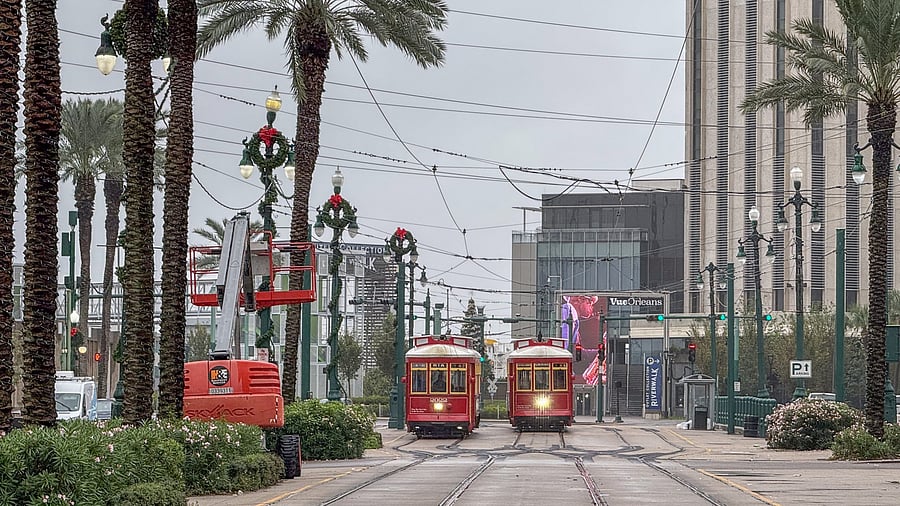
The iconic streetcars of New Orleans offer a unique way to explore the city’s rich history and vibrant culture.
Credit: Sonia Nazareth
Immediately recognisable from generations of paintings and photographs, the city of New Orleans — the birthplace of jazz — exerts an undeniable charm. Founded by the French, administered by the Spanish, and interwoven with African and Caribbean influences, this ever-evolving city stands as a benchmark of resilience and inclusivity. This is no small feat, for the city has repeatedly rebuilt itself after floods, storms, and attacks while adapting over centuries to the challenging delta landscape of South Louisiana.
The French Quarter, or the Vieux Carré — the site of the original New Orleans colony, established by the French in 1718 and now a national historic landmark — embodies my idea of poetry. If you encounter people dancing rather than walking down the streets, hear the occasional clip-clop of horses’ hooves on cobblestone roads, and find jazz as the soundtrack to every corner, chances are you are in this quarter.
As renowned American jazz pianist Ellis Marsalis famously remarked, “In New Orleans, culture does not come down from on high; it bubbles up from the streets.” And that’s exactly how I feel now, wandering amid Caribbean colonial architecture, wrought-iron balconies, mysterious courtyards, authentic jazz clubs, and an abundance of street performances.
Jazz sprang to life in New Orleans around 1895 as a revolutionary musical genre, drawing from blues, ragtime, military marches, and gospel. On a New Orleans Historic Music Tour, I begin at Congo Square (now within Louis Armstrong Park). Considered the cradle of New Orleans music, it is here that I learn how artists creatively blend African-American musical traits — such as Afro-Caribbean rhythms, syncopation, and improvisation — with European instruments and song structures.
Being in the birthplace of jazz makes a visit to Preservation Hall essential. Established in 1961 to honour one of America’s truest art forms — Traditional New Orleans jazz — this venue offers, on any evening of the year, a chance to revel in the music of maestros like John Wendell Brunious and his Preservation Hall All-Stars. However, creative counterpoint is everywhere. That very evening, I visited The Jazz Playhouse for Big Sam’s Funky Nation, a boisterous blend of funk, jazz, rock, and hip-hop.
As dusk falls on historic, energetic, and nocturnal Bourbon Street, neon signs blink to life. Revellers of all nationalities gather in bars and clubs lining the street, some sipping psychedelic cocktails from “go cups.” Even if it’s not Mardi Gras, beads — purple for justice, green for faith, and gold for power — are tossed into the streets, symbolising the offering of these virtues to others. While this spectacle is a burst of high-octane energy, equally unmissable is Frenchmen Street, sometimes called the “locals’ Bourbon Street.” Here, beside the pulsing Frenchmen Art Market — where handcrafted jewellery and paintings abound — you’ll find crowds of locals gathering to enjoy some of the city’s most promising live music acts, spanning jazz, reggae, and blues.
Favourite venues include The Spotted Cat, The Apple Barrel, and Snug Harbor. After a night of musical revelry, I crawl back to my hotel in the early hours, eager for rest before heading to Jackson Square, known for its open-air artist colony. Opposite the St Louis Cathedral, the Presbytère and the Cabildo — both historically significant examples of Spanish colonial architecture and now part of the Louisiana State Museum — stand among a vibrant display of artistry.
Painters diligently create and display their works on the square’s iron fences, poets hammer away on typewriters, and buskers perform. Meanwhile, on nearby Royal Street, a veritable Aladdin’s cave of art and antiquities — ranging from porcelain sets to music boxes — unfolds within quaint galleries.
New Orleans thrives on the iconic. Everywhere, the present and past are in dialogue — from state-of-the-art museums like Vue Orleans to the enduring streetcars that have defined the city’s image for over a hundred years. There really is a streetcar named Desire; Tennessee Williams wrote his famous play of the same name while living in the French Quarter. Hop on one of these traditional streetcars to reach City Park, one of the oldest parks in the country. Amid ancient oak trees draped in picturesque moss canopies, you’ll find exceptional museums like the New Orleans Museum of Art. Just steps away, don’t miss the cutting-edge sculptures in the Sydney and Walda Besthoff Sculpture Garden.
Back in the French Quarter the next morning, I wander along the Mississippi River, once again overwhelmed by competing choices. Should I explore the Historic Voodoo Museum or visit Faulkner House Books, an iconic indie bookstore where William Faulkner once lived and worked?
All I can say is this — if ever you need to be energised by life lived at full throttle, with as much spontaneous improvisation as you can muster, there’s no better inspiration than a few days in and around the Big Easy.